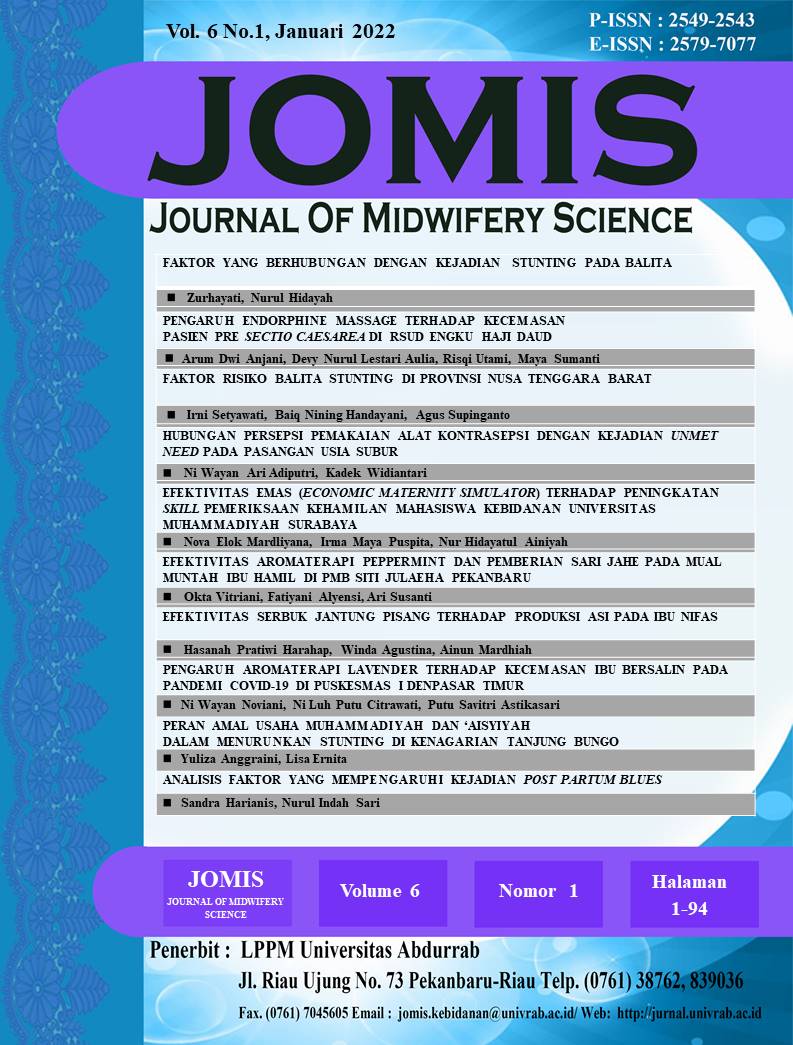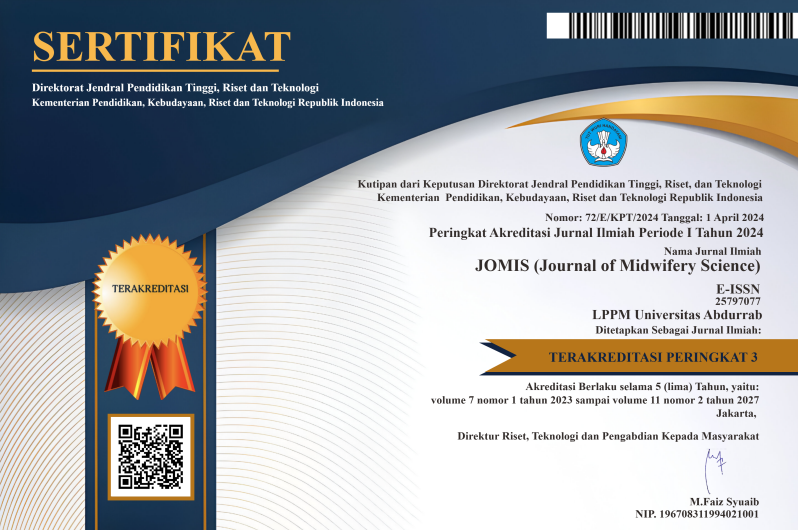ANALISIS FAKTOR YANG MEMPENGARUHI KEJADIAN POST PARTUM BLUES
Faktor Resiko POST PARTUM BLUES
DOI:
https://doi.org/10.36341/jomis.v6i1.2141Keywords:
Postpartum blues, risk factors, incidence rateAbstract
Depression is a common disorder in women of childbearing age. Many women experience depressive symptoms during the postpartum period, ranging from mild postpartum blues to significant mood disorders such as postpartum depression and postpartum psychosis. The ‘postpartum blues‘ are extremely common, affecting 30-75% of new mothers. This form of postpartum mood change is self-limited and requires no specific treatment other than education and support. The aim of this study is to determine analysis risk factors incidence of postpartum blues in Perumnas Public Health Center of Rejang Lebong District. This study used the observational approach with a cross-sectional design. Samples in this study were 73 people used screening instrument of Edinburg Postnatal Depression Scale (EPDS). This study was conducted in Tembilahan Hulu and Gajah Mada Public Health Center in March-April 2021. Data obtained with instrument test and observation sheet. Data analysis used the Chi-Square test (X2. The results of the analysis showed that there was a correlation between postnatal health education provided by health workers (p=0.001, CI 3.225 – 50.404, OR 12.750) and family involvement in taking care of the baby (p=0.003, CI 2.020 – 32.594, OR 8.114) with the incidence of postpartum blues. Meanwhile, pregnancy plans (p=0.736) and delivery complications (p=0.969) based on statistical tests did not have a significant correlation. Social support, information and assistance from health workers are needed for mothers who experience the postpartum blues and screening for the postpartum blues is carried out before the mother is allowed to go home for postpartum care at home
Downloads
References
[2] J. Roito H, N. Nurmailis, and Mardiah, Asuhan Kebidanan Ibu Nifas dan Deteksi Dini Komplikasi. EGC, 2013.
[3] A. M. Abbas, M. N. Salem, M. N. Thabet, and H. Fouly, “Factors affecting the occurrence of postpartum depression among puerperal women in Sohag city, Egypt,†Proc. Obstet. Gynecol., vol. 7, no. 1, p. 4, 2017.
[4] R. Ariesca, S. Helina, and O. Vitriani, “Faktor - Faktor Yang Berhubungan Dengan Kejadian Postpartum Blues Di Klinik Pratama Wilayah Kerja Puskesmas Payung Sekaki Kota Pekanbaru,†J. Prot. Kesehat., vol. 7, no. 1, 2019.
[5] R. P. Sari, A. Densy, and B. Keraman, “Analisis Faktor Risiko Kejadian Postpartum Blues Di Puskesmas Perumnas Kabupaten Rejang Lebong,†J. Midwifery, vol. 8, no. 1, pp. 29–36, 2020.
[6] A. Bener, L. M. Gerber, and J. Sheikh, “Prevalence of psychiatric disorders and associated risk factors in women during their postpartum period: A major public health problem and global comparison,†Int. J. Womens. Health, vol. 4, no. 1, pp. 191–200, 2012.
[7] D. E. Stewart, E. Robertson, M. Phil, C. Dennis, S. L. Grace, and T. Wallington, “Postpartum Depression: Literature review of risk factors and interventions,†WHO Publ., no. October, p. 289, 2003.
[8] C. Henshaw, “Mood disturbance in the early puerperium: a review,†Arch. Women’s Ment. Heal., vol. 6, no. 2, pp. s33–s42, 2003.
[9] “Postpartum mood disorders_ International Review of Psychiatry_ Vol 15, No 3.†.
[10] C. Henshaw, D. Foreman, and J. Cox, “Postnatal blues: A risk factor for postnatal depression,†J. Psychosom. Obstet. Gynecol., vol. 25, no. 3–4, pp. 267–272, Jan. 2004.
[11] M. E. A. Budiman, S. N. J. Sari, W. Kusumawardani, and D. Sutopo, “Strategy Intervention to Prevent and Reduce Postpartum Depression: A Systematic Review,†J. Ners, vol. 14, no. 3, p. 292, 2020.
[12] I. Kumalasari and H. Hendawati, “Faktor Risiko Kejadian Postpartum Blues Di Kota Palembang,†JPP (Jurnal Kesehat. Poltekkes Palembang), vol. 14, no. 2, pp. 91–95, 2019.
Downloads
Published
Issue
Section
License
1. Copyright of all journal manuscripts is held by the JOMIS : Journal of midwifery scinece
2. Formal legal provisions to access digital articles of electronic journal are subject to the provision of the Creative Commons Attribution-ShareAlike license (CC BY-NC-SA), which means that JOMIS : Journal of midwifery scinece is rightful to keep, transfer media/format, manage in the form of databases, maintain, and publish articles.
3. Published manuscripts both printed and electronic are open access for educational, research, and library purposes. Additionally, the editorial board is not responsible for any violations of copyright law.
licensed under a Creative Commons Attribution-ShareAlike 4.0 International License.









